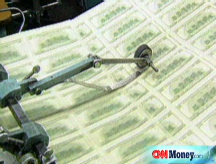Global effort thaws credit freeze
South Korean and Dutch government's backing banks. U.S. Treasury prices mixed as lending becomes easier.
NEW YORK (CNNMoney.com) -- With two more countries entering the global fight to stem the world's financial crisis, lending rates continued to fall Monday, signaling the worldwide effort was easing the stranglehold on lending.
Three major gauges showed a moderate increase in interbank and corporate lending. Banks are charging each other less for loans, and though still at elevated levels, businesses' fears about issuing loans have begun to subside.
The overnight Libor rate fell to 1.51% from 1.67% Friday, according to Bloomberg.com. Libor is a daily average of what 16 different banks charge other banks to lend money in London and is used to calculate adjustable rate mortgages. The higher the rate, the tougher it could be for homeowners to pay those mortgages.
Two weeks ago, overnight Libor spiked as high as 6.88% after the Treasury's $700 billion bailout bill was signed into law on Oct. 3.
For the first time in more than a month, the overnight bank lending rate is at about the rate that the federal banks charge banks - a sign that credit markets are returning to normalcy. The federal funds rate is at 1.5%.
Longer-term lending, though loosening, is still tight: The 3-month Libor marched lower for the sixth day in a row, falling to 4.06% from 4.42% Friday, according to Dow Jones. Last week, the 3-month Libor surged to 4.82% - the highest since mid-December 2007. By comparison, it was under 3% about a month ago.
Overseas help: The South Korean government said Monday it would guarantee up to $100 billion in foreign-currency loans and pump $30 billion into the banking sector. And on Sunday, the Dutch government said it would inject $13.4 billion into ING Groep NV to shore up the bank and insurance company.
The moves are similar to actions taken by the U.S. government and European banks in recent weeks to encourage lending between financial institutions.
"The actions seem to be restoring a little confidence," said Kim Rupert, fixed income analyst with Action Economics. "There are signs that there are enough backstops in the market to free up lending a bit."
While banks had already tightened their lending last summer amid the housing implosion, the markets got really squeezed after Lehman Brothers collapsed last month. The fear was that if one major investment bank could go under in a matter of days, then other seemingly secure firms might not be able to repay their loans.
Federal Reserve chairman Ben Bernanke said in testimony before the House Budget Committee Monday that the fear factor led to the credit pipelines freezing.
"Withdrawals from prime money market mutual funds, which are important suppliers of credit to the commercial paper market, severely disrupted that market; and short-term credit, when available, has become much more costly for virtually all firms," Bernanke said.
As a result, governments around the globe have worked with their central banks to cut interest rates, increase currency exchange programs and pour capital into banks to boost liquidity. The Federal Reserve also will begin to backstop short-term corporate lending next Monday in an effort to unclog the credit pipelines.
"I am confident that these initiatives ... will help restore trust in our financial system and allow the resumption of more normal flows of credit to households and firms," Bernanke added.
Market gauges: Confidence that the global effort was working eased fears in the credit market Monday.
For example, The "TED spread" declined to 2.97 percentage points from 3.63 points Friday. The TED spread measures the difference between the 3-month Libor and the 3-month Treasury bill, and is a key indicator of risk. The higher the spread, the more unwilling investors are to take risks. The spread was 1.04 percentage points just a little over a month ago and reached a record high of 4.65 points a little more than a week ago.
Another indicator, the Libor-OIS spread, also edged slightly lower to 2.93 percentage points from 3.28 points Friday. The Libor-OIS spread measures how much cash is available for lending between banks, and is used for determining lending rates. The bigger the spread, the less cash is available for lending.
Still, the gauges remain high and still have room to fall.
"It's still dicey out there," Rupert said. "We'll probably need to get through the year end without any bumps before we can return to normalcy."
Fannie Mae: The strains on the credit market led government-controlled mortgage financer Fannie Mae (FNM, Fortune 500) to announce Monday that it will not issue benchmark notes this month.
The company issues the notes to finance the mortgages it buys from lenders on the agency market. The agency market works much like the Treasury market, except the government does not guarantee the investment.
The last time Fannie did not issue notes was December. They also did not issue notes in August of last year, when the credit crunch really began to take hold.
With a lack of confidence in corporate debt, some analysts say Fannie's move shows that investors are moving out of the agency market and into the safety of Treasurys and bank debt, which the government now guarantees. With risk concerns still ongoing, short-term debt remains expensive with high interest rates. On the flip side, guaranteed investments are cheaper and more attractive for investors.
"There isn't any liquidity in the agency market," said Bill Larkin, Cabot Money Management portfolio manager. "This may be the end of cheap financing as we know it."
As Fannie and counterpart Freddie Mac compete with banks for short-term funding, mortgage rates have been rising. Last week, Freddie Mac reported the average 30-year fixed-rate mortgage was up at 6.46% from 5.94% the week earlier - the largest weekly increase since April 1987.
Financing for the agencies now comes from the U.S. government, which bailed out the firms in early September. Previously, they had been government-sponsored enterprises - private companies that could draw on the Treasury for capital.
Treasurys: Government debt prices were mixed Monday, even as the stock market rose on the global coordinated effort to fix the financial crisis. Investors cheered Bernanke's suggestion that Congress offer another economic stimulus package but were jittery over his dour long-term assessment of the economy.
As a result, long-term bonds rose and short-term Treasurys fell.
The benchmark 10-year note rose 23/32 to 101-9/32, and its yield fell to 3.83% from 3.93% late Friday. Bond prices and yields move in opposite directions.
The 30-year bond climbed 1-8/32 to 104-9/32, and the yield sank to 4.24% from 4.34%.
But the 2-year note fell 6/32 to 100-17/32, and its yield rose to 1.7% from 1.62% late Friday.
The yield on the 3-month bill rose to 1.98%, up from 0.79% on Friday. It was the first time the 3-month yield rose above 1% since Sept. 22.
The yield on the 3-month Treasury bill is closely watched as an immediate reading on investor confidence. Investors and money-market funds shuffle funds into and out of the 3-month bill frequently, as they assess risk in the rest of the marketplace. A higher yield indicates that investors are slightly more optimistic. ![]()




